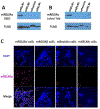Choosing the right antibody for resistin-like molecule (RELM/FIZZ) family members
- PMID: 23076260
- PMCID: PMC6822273
- DOI: 10.1007/s00418-012-1042-0
Choosing the right antibody for resistin-like molecule (RELM/FIZZ) family members
Abstract
The family of resistin-like molecules (RELM), also known as found in inflammatory zone (FIZZ), consists of four members in mouse (RELMα/FIZZ1/HIMF, RELMβ/FIZZ2, Resistin/FIZZ3, and RELMγ/FIZZ4) and two members in human (resistin and RELMβ). The importance of these proteins in many aspects of physiology and pathophysiology, especially inflammatory processes, is rapidly evolving in the literature, and many investigators are beginning to work in this field. Most published studies focus on only one isoform, do not evaluate other isoforms that might be present, and have not tested for the specificity of the antibody used. Because RELM isoforms have high sequence and structural similarity and both distinct and overlapping functions, it is important to use a specific antibody to distinguish each isoform in the study. We constructed and established HEK 293 cell lines that constitutively express each isoform. Using these cell lines, we determined the specificity of antibodies (both commercially available and laboratory-made) to each isoform by Western blot and immunofluorescence. Some of the antibodies showed specificity in Western blotting but were not applicable in immunofluorescence. Others showed cross reactivity in Western blot assays. Our results indicate that RELM antibody specificity should be taken into account when using them in research and interpreting data obtained with them.
Figures






Similar articles
-
Resistin family proteins in pulmonary diseases.Am J Physiol Lung Cell Mol Physiol. 2020 Sep 1;319(3):L422-L434. doi: 10.1152/ajplung.00040.2020. Epub 2020 Jun 17. Am J Physiol Lung Cell Mol Physiol. 2020. PMID: 32692581 Free PMC article. Review.
-
Adiponectin and resistin--new hormones of white adipose tissue.Med Sci Monit. 2003 Feb;9(2):RA55-61. Med Sci Monit. 2003. PMID: 12601307 Review.
-
Resistin-like molecule β is abundantly expressed in foam cells and is involved in atherosclerosis development.Arterioscler Thromb Vasc Biol. 2013 Aug;33(8):1986-93. doi: 10.1161/ATVBAHA.113.301546. Epub 2013 May 23. Arterioscler Thromb Vasc Biol. 2013. PMID: 23702657
-
Comparative studies of resistin expression and phylogenomics in human and mouse.Biochem Biophys Res Commun. 2003 Oct 24;310(3):927-35. doi: 10.1016/j.bbrc.2003.09.093. Biochem Biophys Res Commun. 2003. PMID: 14550293
-
Identification of RELMgamma, a novel resistin-like molecule with a distinct expression pattern.Genomics. 2003 Jun;81(6):588-95. doi: 10.1016/s0888-7543(03)00070-3. Genomics. 2003. PMID: 12782128
Cited by
-
Resistin-Like Molecule α in Allergen-Induced Pulmonary Vascular Remodeling.Am J Respir Cell Mol Biol. 2015 Sep;53(3):303-13. doi: 10.1165/rcmb.2014-0322OC. Am J Respir Cell Mol Biol. 2015. PMID: 25569618 Free PMC article.
-
Systemic evaluation and localization of resistin expression in normal human tissues by a newly developed monoclonal antibody.PLoS One. 2020 Jul 1;15(7):e0235546. doi: 10.1371/journal.pone.0235546. eCollection 2020. PLoS One. 2020. PMID: 32609743 Free PMC article.
-
Resistin predicts disease severity and survival in patients with pulmonary arterial hypertension.Respir Res. 2024 Jun 6;25(1):235. doi: 10.1186/s12931-024-02861-8. Respir Res. 2024. PMID: 38844967 Free PMC article.
-
The Histochem Cell Biol conspectus: the year 2013 in review.Histochem Cell Biol. 2014 Apr;141(4):337-63. doi: 10.1007/s00418-014-1207-0. Epub 2014 Mar 9. Histochem Cell Biol. 2014. PMID: 24610091 Free PMC article. Review.
-
Resistin family proteins in pulmonary diseases.Am J Physiol Lung Cell Mol Physiol. 2020 Sep 1;319(3):L422-L434. doi: 10.1152/ajplung.00040.2020. Epub 2020 Jun 17. Am J Physiol Lung Cell Mol Physiol. 2020. PMID: 32692581 Free PMC article. Review.
References
-
- Banerjee RR, Lazar MA (2001) Dimerization of resistin and resistin-like molecules is determined by a single cysteine. J Biol Chem 276:25970–25973. - PubMed
-
- Campbell E, Pearson RC, Parkinson D (1999) Methods to uncover an antibody epitope in the KPI domain of Alzheimer’s amyloid precursor protein for immunohistochemistry in human brain. J Neurosci Methods 93:133–138. - PubMed
-
- Chumakov AM, Kubota T, Walter S, Koeffler HP (2004) Identification of murine and human XCP1 genes as C/EBP-epsilon-dependent members of FIZZ/Resistin gene family. Oncogene 23:3414–3425. - PubMed
Publication types
MeSH terms
Substances
Grants and funding
LinkOut - more resources
Full Text Sources
Other Literature Sources
Miscellaneous

